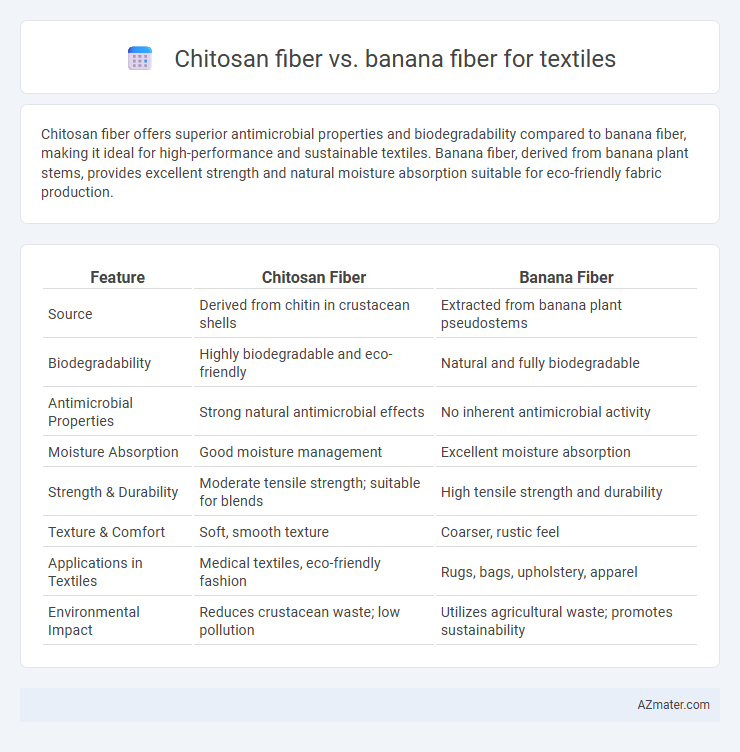Chitosan fiber offers superior antimicrobial properties and biodegradability compared to banana fiber, making it ideal for high-performance and sustainable textiles. Banana fiber, derived from banana plant stems, provides excellent strength and natural moisture absorption suitable for eco-friendly fabric production.
Table of Comparison
| Feature | Chitosan Fiber | Banana Fiber |
|---|---|---|
| Source | Derived from chitin in crustacean shells | Extracted from banana plant pseudostems |
| Biodegradability | Highly biodegradable and eco-friendly | Natural and fully biodegradable |
| Antimicrobial Properties | Strong natural antimicrobial effects | No inherent antimicrobial activity |
| Moisture Absorption | Good moisture management | Excellent moisture absorption |
| Strength & Durability | Moderate tensile strength; suitable for blends | High tensile strength and durability |
| Texture & Comfort | Soft, smooth texture | Coarser, rustic feel |
| Applications in Textiles | Medical textiles, eco-friendly fashion | Rugs, bags, upholstery, apparel |
| Environmental Impact | Reduces crustacean waste; low pollution | Utilizes agricultural waste; promotes sustainability |
Introduction to Chitosan and Banana Fibers
Chitosan fiber, derived from chitin found in crustacean shells, offers natural antibacterial and biodegradable properties making it suitable for sustainable textile applications. Banana fiber, extracted from the pseudostem of banana plants, is a strong, eco-friendly natural fiber valued for its durability and breathability in fabric production. Both fibers provide innovative alternatives to conventional textiles, promoting environmental sustainability and functional performance in the fashion industry.
Source and Extraction Methods
Chitosan fiber is derived from chitin found in crustacean shells, primarily shrimp and crab, through deacetylation involving chemical treatment with alkali solutions. Banana fiber is extracted from the pseudostem of banana plants using mechanical decortication followed by chemical treatments such as retting or alkaline retting to separate the fibers. Both fibers rely on biomass waste but differ significantly, as chitosan fiber originates from marine sources with biopolymer extraction, while banana fiber comes from plant agricultural residues extracted through mechanical and chemical processes.
Chemical Composition and Structure
Chitosan fiber, derived from chitin, primarily consists of b-(1-4)-linked D-glucosamine and N-acetyl-D-glucosamine units, imparting antimicrobial properties and enhanced biodegradability, while its crystalline structure ensures high tensile strength and moisture retention. Banana fiber, extracted from Musa plant pseudostems, is composed mainly of cellulose (around 60-70%), hemicellulose, and lignin, offering a natural polymer matrix with strong microfibrillar orientation that provides durability and breathability. The chemical backbone difference--chitosan's amino polysaccharide versus banana's cellulose-rich composition--affects fiber reactivity, dye affinity, and end-use performance in textiles.
Mechanical Properties Comparison
Chitosan fiber exhibits higher tensile strength and better elasticity compared to banana fiber, making it more suitable for applications requiring durability and flexibility. Banana fiber, while possessing moderate tensile strength, provides superior rigidity and abrasion resistance, which benefits coarse textile products. Both fibers demonstrate unique mechanical properties that cater to different textile performance requirements, with chitosan excelling in strength and elasticity and banana fiber offering robustness and wear resistance.
Biodegradability and Environmental Impact
Chitosan fiber, derived from crustacean shells, offers superior biodegradability due to its natural biopolymer composition, breaking down efficiently without releasing toxic residues, which minimizes environmental impact. Banana fiber, extracted from banana plant stalks, is highly sustainable as it utilizes agricultural waste, biodegrades rapidly, and reduces landfill waste while supporting circular economy principles. Both fibers present eco-friendly alternatives to synthetic textiles, but banana fiber's renewable sourcing and chitosan's antimicrobial properties enhance their environmental benefits in sustainable textile applications.
Dyeability and Finishing Characteristics
Chitosan fiber exhibits superior dyeability due to its natural amino groups that enhance dye uptake and fixation, resulting in vibrant and long-lasting colors compared to banana fiber. Banana fiber, derived from Musa plant stalks, has a coarse texture and lower affinity for synthetic dyes, often requiring pretreatment for better dye penetration and uniformity. Finishing characteristics of chitosan fiber include excellent antimicrobial properties and smooth texture, whereas banana fiber offers stiffness and durability but may require additional softening processes for improved fabric hand feel.
Comfort and Wearability Factors
Chitosan fiber offers superior antibacterial properties and moisture absorption, enhancing comfort by reducing odor and skin irritation, making it ideal for sensitive skin applications. Banana fiber provides excellent breathability and natural UV protection, contributing to a cool and comfortable wear experience, especially in warm climates. Both fibers exhibit good durability, but chitosan fiber's softness and hypoallergenic nature give it a distinct advantage in wearability over banana fiber's coarser texture.
Cost and Commercial Viability
Chitosan fiber is generally more expensive than banana fiber due to its complex extraction and processing methods involving crustacean shells, which increases production costs. Banana fiber offers better commercial viability with lower raw material costs and established supply chains from banana plant waste, making it a sustainable and cost-effective option for textile manufacturing. While chitosan fibers provide antibacterial properties, banana fiber's affordability and ease of large-scale production make it more attractive for mainstream textile applications.
Applications in the Textile Industry
Chitosan fiber exhibits excellent antimicrobial properties and biodegradability, making it ideal for medical textiles, sportswear, and activewear that require odor control and enhanced hygiene. Banana fiber, known for its high tensile strength and natural luster, is predominantly used in eco-friendly fashion, upholstery, and sustainable textile composites. Both fibers contribute to the development of sustainable textiles but target different applications based on their unique functional and mechanical properties.
Future Prospects and Research Trends
Chitosan fiber, derived from chitin in crustacean shells, exhibits strong antimicrobial properties and biodegradability, making it a promising material for sustainable textiles with enhanced hygiene applications. Banana fiber, extracted from banana plant stems, offers excellent mechanical strength and eco-friendly production, appealing to the growing demand for natural and renewable textile fibers. Current research trends emphasize blending these fibers with synthetic materials to improve durability and functionality, while future prospects focus on scalable extraction methods and innovative treatment processes to expand their commercial viability in the textile industry.

Infographic: Chitosan fiber vs Banana fiber for Textile
 azmater.com
azmater.com